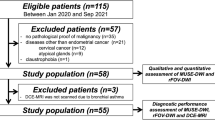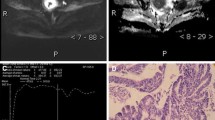Abstract
Objectives
To compare the diagnostic accuracy of diffusion-weighted (DW) and dynamic contrast-enhanced (DCE) magnetic resonance (MR) imaging for detecting cervical stromal invasion in endometrial cancer.
Methods
Eighty-three consecutive women with endometrial cancer underwent preoperative evaluation in a 3-T unit, including T2-weighted, DW (b = 0 and 1000 s/mm2), and DCE MR imaging. Two radiologists independently assessed presence of cervical stromal invasion, with histopathological reference as gold standard.
Results
For assessing cervical stromal invasion, the diagnostic accuracy, sensitivity, and specificity, respectively for Reader 1/Reader 2, were as follows: DW MR imaging— 95.2 %/91.6 %, 91.7 %/100 %, and 95.8 %/90.1 %; DCE MR imaging— 91.6 %/88 %, 58.3 %/50 %, and 97.2 %/94.4 %. The diagnostic performance of DW MR imaging (Reader 1: areas under the receiver operating characteristic curve (AUC) = 0.98; Reader 2: AUC = 0.97) was significantly higher than that of DCE MR imaging (p = 0.009 for Reader 2) or T2-weighted MR imaging (Reader 1: p = 0.006; Reader 2: p = 0.013). Patients with cervical stromal invasion showed a significantly greater canal width (p < 0.0001) and myometrial invasion extent (p = 0.006).
Conclusions
DW MR imaging has superior diagnostic performance compared with DCE MR imaging in the detection of cervical stromal invasion.
Key Points
• DWI demonstrates a higher accuracy than DCE in detecting cervical stromal invasion.
• Tumour ADC values are similar between patients without or with cervical invasion.
• Canal widening causes false-negativity on DCE and T2W but not on DWI.





Similar content being viewed by others
Abbreviations
- ADC:
-
Apparent diffusion coefficient
- AUC:
-
Areas under the receiver operating characteristics curve
- CA-125:
-
Cancer antigen 125
- DCE:
-
Dynamic contrast-enhanced
- DW:
-
Diffusion-weighted
- FIGO:
-
International Federation of Gynecology and Obstetrics
- FOV:
-
Field of view
- MR:
-
Magnetic resonance
- NCCN:
-
National Comprehensive Cancer Network
- ROI:
-
Region of interest
- TR:
-
Repetition time
- TE:
-
Echo time
References
Siegel RL, Miller KD, Jemal A (2016) Cancer statistics, 2016. CA Cancer J Clin 66:7–30
Turan T, Hizli D, Yilmaz SS et al (2012) What is the impact of cervical invasion on lymph node metastasis in patients with stage IIIC endometrial cancer? Arch Gynecol Obstet 285:1119–1124
Solmaz U, Mat E, Dereli M et al (2015) Lymphovascular space invasion and cervical stromal invasion are independent risk factors for nodal metastasis in endometrioid endometrial cancer. Aust N Z J Obstet Gynaecol 55:81–86
Taskin S, Ortac F, Kahraman K, Goc G, Oztuna D, Gungor M (2013) Cervical stromal involvement can predict survival in advanced endometrial carcinoma: a review of 67 patients. Int J Clin Oncol 18:105–109
Kwon JS, Qiu F, Saskin R, Carey MS (2009) Are uterine risk factors more important than nodal status in predicting survival in endometrial cancer? Obstet Gynecol 114:736–743
Ferriss JS, Brix W, Tambouret R, DeSimone CP, Stoler M, Modesitt SC (2010) Cervical stromal invasion predicting survival in endometrial cancer. Obstet Gynecol 116:1035–1041
Tewari KS, Filiaci VL, Spirtos NM et al (2012) Association of number of positive nodes and cervical stroma invasion with outcome of advanced endometrial cancer treated with chemotherapy or whole abdominal irradiation: a Gynecologic Oncology Group study. Gynecol Oncol 125:87–93
Pecorelli S (2009) Revised FIGO staging for carcinoma of the vulva, cervix, and endometrium. Int J Gynaecol Obstet 105:103–104
NCCN Clinical Practice Guidelines in Oncology: Uterine Cancers. National Comprehensive Cancer Network, USA. Available via http://www.nccn.org/professionals/physician_gls/pdf/uterine.pdf. Accessed 23 May, 2016
American College of O, Gynecologists (2005) ACOG practice bulletin, clinical management guidelines for obstetrician-gynecologists, number 65, August 2005: management of endometrial cancer. Obstet Gynecol 106:413–425
Eskander RN, Randall LM, Berman ML, Tewari KS, Disaia PJ, Bristow RE (2011) Fertility preserving options in patients with gynecologic malignancies. Am J Obstet Gynecol 205:103–110
Manfredi R, Mirk P, Maresca G et al (2004) Local-regional staging of endometrial carcinoma: role of MR imaging in surgical planning. Radiology 231:372–378
Kinkel K, Kaji Y, Yu KK et al (1999) Radiologic staging in patients with endometrial cancer: a meta-analysis. Radiology 212:711–718
Ortashi O, Jain S, Emannuel O, Henry R, Wood A, Evans J (2008) Evaluation of the sensitivity, specificity, positive and negative predictive values of preoperative magnetic resonance imaging for staging endometrial cancer. A prospective study of 100 cases at the Dorset Cancer Centre. Eur J Obstet Gynecol Reprod Biol 137:232–235
Cicinelli E, Marinaccio M, Barba B et al (2008) Reliability of diagnostic fluid hysteroscopy in the assessment of cervical invasion by endometrial carcinoma: a comparative study with transvaginal sonography and MRI. Gynecol Oncol 111:55–61
Mascilini F, Testa AC, Van Holsbeke C, Ameye L, Timmerman D, Epstein E (2013) Evaluating myometrial and cervical invasion in women with endometrial cancer: comparing subjective assessment with objective measurement techniques. Ultrasound Obstet Gynecol 42:353–358
Haldorsen IS, Berg A, Werner HM et al (2012) Magnetic resonance imaging performs better than endocervical curettage for preoperative prediction of cervical stromal invasion in endometrial carcinomas. Gynecol Oncol 126:413–418
Luomaranta A, Leminen A, Loukovaara M (2015) Magnetic resonance imaging in the assessment of high-risk features of endometrial carcinoma: a meta-analysis. Int J Gynecol Cancer 25:837–842
Rauch GM, Kaur H, Choi H et al (2014) Optimization of MR imaging for pretreatment evaluation of patients with endometrial and cervical cancer. Radiographics 34:1082–1098
Larson DM, Connor GP, Broste SK, Krawisz BR, Johnson KK (1996) Prognostic significance of gross myometrial invasion with endometrial cancer. Obstet Gynecol 88:394–398
Nagar H, Dobbs S, McClelland HR, Price J, McCluggage WG, Grey A (2006) The diagnostic accuracy of magnetic resonance imaging in detecting cervical involvement in endometrial cancer. Gynecol Oncol 103:431–434
Seki H, Takano T, Sakai K (2000) Value of dynamic MR imaging in assessing endometrial carcinoma involvement of the cervix. AJR Am J Roentgenol 175:171–176
Freeman SJ, Aly AM, Kataoka MY, Addley HC, Reinhold C, Sala E (2012) The revised FIGO staging system for uterine malignancies: implications for MR imaging. Radiographics 32:1805–1827
Lin G, Ng KK, Chang CJ et al (2009) Myometrial invasion in endometrial cancer: diagnostic accuracy of diffusion-weighted 3.0-T MR imaging--initial experience. Radiology 250:784–792
Beddy P, Moyle P, Kataoka M et al (2012) Evaluation of depth of myometrial invasion and overall staging in endometrial cancer: comparison of diffusion-weighted and dynamic contrast-enhanced MR imaging. Radiology 262:530–537
Kinkel K, Forstner R, Danza FM et al (2009) Staging of endometrial cancer with MRI: guidelines of the European Society of Urogenital Imaging. Eur Radiol 19:1565–1574
Koplay M, Dogan NU, Erdogan H et al (2014) Diagnostic efficacy of diffusion-weighted MRI for pre-operative assessment of myometrial and cervical invasion and pelvic lymph node metastasis in endometrial carcinoma. J Med Imaging Radiat Oncol 58:538–546
Hori M, Kim T, Onishi H et al (2013) Endometrial cancer: preoperative staging using three-dimensional T2-weighted turbo spin-echo and diffusion-weighted MR imaging at 3.0 T: a prospective comparative study. Eur Radiol 23:2296–2305
Bonatti M, Stuefer J, Oberhofer N et al (2015) MRI for local staging of endometrial carcinoma: Is endovenous contrast medium administration still needed? Eur J Radiol 84:208–214
Lin G, Huang YT, Chao A et al (2015) Influence of menopausal status on diagnostic accuracy of myometrial invasion in endometrial cancer: diffusion-weighted and dynamic contrast-enhanced MRI at 3 T. Clin Radiol 70:1260–1268
Sanjuan A, Escaramis G, Ayuso JR et al (2008) Role of magnetic resonance imaging and cause of pitfalls in detecting myometrial invasion and cervical involvement in endometrial cancer. Arch Gynecol Obstet 278:535–539
Tamai K, Koyama T, Saga T et al (2007) Diffusion-weighted MR imaging of uterine endometrial cancer. J Magn Reson Imaging 26:682–687
Kurman RJ (2002) Blaustein’s pathology of the female genital tract, 5 edn. Springer, Berlin Heidelberg New York
McCluggage WG, Hirschowitz L, Wilson GE, Oliva E, Soslow RA, Zaino RJ (2011) Significant variation in the assessment of cervical involvement in endometrial carcinoma: an interobserver variation study. Am J Surg Pathol 35:289–294
Fleiss JL (1981) Statistical methods for rates and proportions. Wiley, New York
Medina LS, Zurakowski D (2003) Measurement variability and confidence intervals in medicine: why should radiologists care? Radiology 226:297–301
Emlik D, Kiresi D, Ozdemir S, Celik C, Karakose S (2010) Preoperative assessment of myometrial and cervical invasion in endometrial carcinoma: comparison of multi-section dynamic MR imaging using a three dimensional FLASH technique and T2-weighted MR imaging. J Med Imaging Radiat Oncol 54:202–210
Antonsen SL, Jensen LN, Loft A et al (2013) MRI, PET/CT and ultrasound in the preoperative staging of endometrial cancer - a multicenter prospective comparative study. Gynecol Oncol 128:300–308
Duncan KA, Drinkwater KJ, Frost C, Remedios D, Barter S (2012) Staging cancer of the uterus: a national audit of MRI accuracy. Clin Radiol 67:523–530
Vasconcelos C, Felix A, Cunha TM (2007) Preoperative assessment of deep myometrial and cervical invasion in endometrial carcinoma: comparison of magnetic resonance imaging and histopathologic evaluation. J Obstet Gynaecol 27:65–70
Cabrita S, Rodrigues H, Abreu R et al (2008) Magnetic resonance imaging in the preoperative staging of endometrial carcinoma. Eur J Gynaecol Oncol 29:135–137
Teng F, Zhang YF, Wang YM et al (2015) Contrast-enhanced MRI in preoperative assessment of myometrial and cervical invasion, and lymph node metastasis: diagnostic value and error analysis in endometrial carcinoma. Acta Obstet Gynecol Scand 94:266–273
Ascher SM, Reinhold C (2002) Imaging of cancer of the endometrium. Radiol Clin North Am 40:563–576
Cao K, Gao M, Sun YS et al (2012) Apparent diffusion coefficient of diffusion weighted MRI in endometrial carcinoma-relationship with local invasiveness. Eur J Radiol 81:1926–1930
Shih IL, Yen RF, Chen CA et al (2015) Standardized uptake value and apparent diffusion coefficient of endometrial cancer evaluated with integrated whole-body PET/MR: correlation with pathological prognostic factors. J Magn Reson Imaging 42:1723–1732
Nougaret S, Reinhold C, Alsharif SS et al (2015) Endometrial cancer: combined MR volumetry and diffusion-weighted imaging for assessment of myometrial and lymphovascular invasion and tumor grade. Radiology 276:797–808
Padhani AR, Koh DM, Collins DJ (2011) Whole-body diffusion-weighted MR imaging in cancer: current status and research directions. Radiology 261:700–771
Acknowledgments
The authors thank all the members of the Cancer Center, Chang Gung Memorial Hospital, for their invaluable help. The scientific guarantor of this publication is Chyong-Huey Lai. The authors of this manuscript declare no relationships with any companies, whose products or services may be related to the subject matter of the article. This study has received funding by Chang Gung Medical Foundation grant CMRPG-3B1923, CIRPG3E0021, National Science Council (Taiwan) 104-2314-B-182A-095-MY3. Dr Lan-Yan Yang kindly provided statistical advice for this manuscript. Institutional Review Board approval was obtained. Written informed consent was obtained from all subjects (patients) in this study. Chang Gung IRB No. 101-2187B, 103-7316A3. The authors thank all the members of the Cancer Center, Chang Gung Memorial Hospital, for their invaluable help.
Some study subjects or cohorts had been previously reported to investigate the influence of menopausal status on diagnostic accuracy of MR imaging for evaluation of myometrial invasion: Lin G, Huang YT, Chao A, et al (2015) Influence of menopausal status on diagnostic accuracy of myometrial invasion in endometrial cancer: diffusion-weighted and dynamic contrast-enhanced MRI at 3 T. Clin Radiol 70:1260-1268. In the current manuscript we selected the 83 patients who had completed hysterectomy and compared the accuracy of DW and DCE MR imaging in diagnosis of cervical stromal invasion in endometrial cancer.
Methodology: prospective, diagnostic or prognostic study, performed at one institution.
Author information
Authors and Affiliations
Corresponding author
Rights and permissions
About this article
Cite this article
Lin, G., Huang, YT., Chao, A. et al. Endometrial cancer with cervical stromal invasion: diagnostic accuracy of diffusion-weighted and dynamic contrast enhanced MR imaging at 3T. Eur Radiol 27, 1867–1876 (2017). https://doi.org/10.1007/s00330-016-4583-0
Received:
Revised:
Accepted:
Published:
Issue Date:
DOI: https://doi.org/10.1007/s00330-016-4583-0




